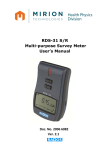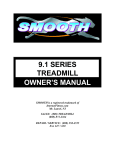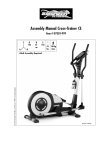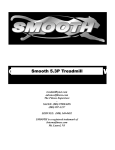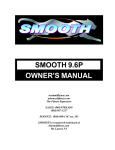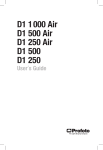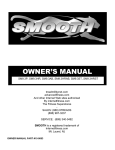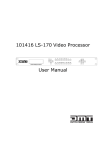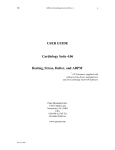Download Smooth Fitness SMOOTH CE 07858-699 User's Manual
Transcript
Computer- and training instructions Smooth CE model # 07858-699 Function and operation of the training computer For Your Safety: Before beginning your program of exercise, consult your doctor to ensure that you are fit enough to use the equipment. Base your program of exercise on the advice given by your doctor. Incorrect or excessive exercise may damage your health. Operating instructions for the training computer with digital display f e d c g h 5 6 i k l m 7 n 10 c 4 b 3 a 2 1 9 8 12 11 14 13 (NOTICE: All illustrations and texts are explaint by the metric version of distance/temperature KILOMETERS/°C. Computer itsselfs calculates with MILES/°F.) m % per cent n room temperature degree Celsius ° % of max. pulse setting Keys 8 Recovery key function key (recovery pulse and fitness value calculation) 9 Reset key function key (delete the display contents) 10 Set key function key (acceptance and confirmation of inputs) 11 Program key selection of programs and display contents in graphics field 12 Minus key reduce values 13 Plus key increase values Connections (front) 14 Socket for the ear-clip and the plug-in receiver Connections (board) 15 Plug (4-pole) for the hand pulse sensors 16 Plug (6-pole) for voltage, impulses and control 17 Plug (3-pole) to interface Connections (rear) 18 Socket interface PC connection 1.0 Displays before training 1. Room temperature Fig. 1 [before and after training] 2. Full display Fig. 2 [after pedalling or key actuation, 1 sec] 3. Total kilometres Fig. 3 [all kilometres covered, 8 sec] 4. Start display Fig. 4 [after key actuation or after 8 seconds] Í Î Ï Y Y Values 1. KILOJOULE energy consumption room temperature odo total kilometres 0-9999 [KJ] 0-50 [°C] 0-9999 [km] 2. RPM pedal rotations 20-199 [rotations/min] 3. TIME 0:00-99:59 [min:sec] 4. KM/H velocity 0-99,9 [km/h] 5. KM distance 0-99,9 [km] 6. WATT performance 25-400 [Watt] 7. PULSE pulse beat 0-199 [pulse beats/min] Symbols ▲▼ arrows change pedal rotations b Ø RPM + km/h + performance + pulse c ❶-➏ program 1-6 given training programs d count-down mode training values count down e count-up mode KM/H KM ∅ LO TIME O Figure 1 RPM ∅ WATT KILOJOULE O % ∅ HI PULSE Figure 2 Full display Y KM/H KM WATT KILOJOULE PULSE TIME RPM Figure 3 Total kolometre display Figure 4 Start display Count up training values count up f ■■■ graphic display multiple display for graphics+values g ❤ heart program pulse controlled program h interface PC mode i LO low pulse limit age-depending low pulse limit k ❤ pulse beat flashes in accordance with pulse beat l HI high pulse limit age-depending high pulse limit, max. pulse (flashes) 2 ∅ KM a average Ê Ë Ì 2.0 Pulse measuring This display offers three possibilities for pulse measuring: 1. with the hand pulse sensors 2. with the ear-clip 3. with the cardio pulse set, article No. 07937-000 (available as an option from specialised dealers) Í Î Ï Y Y Information on pulse measuring Only one kind of pulse measuring is possible at a time. (Ear-clip or hand pulse sensors or cardio pulse set) Ê Ë Ì TIME Select the start display (Fig. 4). Your current pulse is displayed at position (7). Figure 7 Programs ➊-➏ Example:❷ Pulse measuring with hand pulse sensors Your hands grasp the hand pulse sensors. Figure 8 Heart rate control program: HRC Pulse measuring with the ear-clip 4.3 Settings in the programs count-down and HRC Plug the ear-clip into socket (14). Rub one ear lob in order to achieve a better blood circulation. Put the ear-clip at your ear lob. You have selected a program, e.g. count-down (Fig. 6). Pulse measuring with the cardio pulse set Please refer to the appropriate instructions. If you press the set key, the setting mode will open (Fig. 9). No preset data are represented by "Off" in the graphics field (Fig. 9). With the +/– keys (12/13) you can adjust the setting values (Fig. 10). If you press the –/+ key longer, forward or reverse run will be carried out faster. If you press the –/+ keys together, the value will be reset to zero. Pulse display The heart symbol (j) will flash according to your pulse beat. The pulse beat is displayed as value (7). With the set key you will get to the next preset data. (Fig. 10-12). Note: Step into the pedals. All values will count up. Count-up mode. Y 3.0 Training without preset training data Fig. 8 shows the initial call of the HRC programme. An entered target pulse will be stored, and the next time the programme is called this pulse will be displayed and monitored following immediate commencement of the training session Y 4.0 Training with preset training data KM 4.1 Program types KM The crosstrainer possesses nine different program types: • Count-up (count-up mode) • 6 programs 1-6 (preset training intervals in a given time) • pulse controlled program (strain control based on your preset pulse value) Figure 9 No setting "Off" Figure 10 Distance setting e.g. 16.5 km Y • Count-down (count-down mode) After switching on, count-up (Fig. 4) will be automatically activated. 4.2 Selection of programs (Fig. 5-8) TIME You set the start display (Fig. 8). Press the program key (11) several times without pedalling. The programs are shown in the display by flashing program symbols. In case of count-up, countdown and HRC text is displayed in the graphics field (f). In the programs ➊-➏, additionally the training profile is shown in graphics field (f) in a compressed form. The training time given by the program will be shown in the time display (3) (Fig. 7). Y Ê Ë Ì Í Î Ï Figure 5 Count up mode: Count up Y Y Y Ê Ë Ì Í Î Ï Figure 11 Figure 12 Time setting e.g. 34 minutes Kilojoule setting e.g. 820 kJ 4.4 Possibilities of preset pulse values The schematic diagram shows the sequence for preset pulse values Figure 6 Count down mode: Count Down 3 4.4.2 Max. pulse Age input OFF, 10-99 with +/- Max. pulse input OFF, 80-199, 80-(220-age) with +/- key After the entry of an age in the max. pulse display the calculated value will appear in the graphics fields (Fig. 16). Additionally, the % symbol and 100 appear in the PULSE display. If no age has been preset, a max. pulse between 80 and 199 can be entered. Input no (OFF) Input yes Pulse input: Fat consumption 65% (220-age)*0.65, (max. pulse)*0.65 Pulse input: Fitness 75% (220-age)*0.75, (max. pulse)*0.75 Figure 15 No input “OFF” Figure 16 Max. pulse displayed with input 31 years with 100% - symbol If the max. pulse is to be lower than the calculated value, press the – key (12). An increase exceeding the max. value is not possible. Pulse selection: Manual - - % Note Pulse value input: OFF, 40-188 with +(- key Input yes Pulse input: Manual 40-90% (220-age)*0.40-0.90 (max. pulse)*0.40-0.90 with +/- key Input no (OFF) Input no (OFF) A previously calculated or altered max. pulse in HRC program will be adopted. Function Preset: Training pulse Through the age input and the adopted or altered max. pulse a pulse monitoring is activated which will indicate an exceeding value by means of a flashing HI symbol. The value shown with the % symbol is the comparison between current pulse value and max. pulse value. If you do not enter any max. pulse value, the subsequently described pulse zone inputs are not possible and you will get to the entry of a freely selectable pulse value monitoring (item 4.4.3). With the set key you subsequently call 3 input ranges. 4.4.3 Pulse zones/training targets Input yes Training without Training without % and without HI/LO % with HI/LO Training with % and HI/LO Training with % and without HI/LO In detail: 1. Age (Fig. 13/14) 2. Max. pulse (Fig. 15 / Fig. 16) 3. Pulse zones: Training target ➠ fat consumption [fat 65%] (Fig. 17) Training target ➠ cardiovascular fitness [fit 75%] (Fig. 18) Manual [man. - - %] (Fig. 19/20) 4.4.1 Age input The age input is required for calculating the max. pulse. With the +/- keys you select 3 zones. The age input and/or the altered max. pulse are used for calculating this pulse zone which is visible in the PULSE display (7). 1. Training target ➠ fat consumption [Fat 65%] (Fig. 17) Formula: (220 - age) x 0.65 or max. pulse x 0.65 2. Training target ➠ cardiovascular fitness [Fit 75%] (Fig. 18) Formula: (220 - age) x 0.75 or max. pulse x 0.75 3. Manual zone [Man - - %] (Fig. 19) You set the factor in the range of 40 - 90 % with the +/- keys. Formula: (220 - age) x (0.40 - 0.90) or max. pulse x (0.40 - 0,90) Figure 13 No input “OFF” Figure 14 Age z.B.31with max. pulse setting 189 and HI - symbol If you enter your age, the age-depending max. pulse (formula: 220 - age) will appear in the PULSE display (7). (Fig. 14) In case of inputs up to 21 years, only 199 can be shown as the max. pulse, however, the calculation is based upon the correct value. Note If you entered an age in the HRC program before, this value will be shown. 4 Fig. 17 Pulse zone: Fat consumption with 65% Fig. 18 Pulse zone: Fitness with 75 % Y KM/H KM WATT KILOJOULE PULSE TIME RPM Fig. 19 Fig. 20 Manual pulse selection Manual pulse input, e.g. 85% With the set key you accept the pulse zone and get to completion of preset data (item 4.4.5.). Function Through the pulse zone input and the accepted or altered max. pulse a pulse zone monitoring is activated. If you fall below the preset training pulse by 11 beats, the lettering "LO" appears; if you exceed it by 11 beats, the display will show "HI". The "LO" monitoring is active, if the preset training pulse is reached for the first time when pedalling. If the pedal speed falls to zeros, the "LO" function will become active again when reaching the preset training pulse. The "HI" monitoring is always active. The value which is displayed with the % symbol is the comparison between current pulse value and max. pulse value. If you do not enter any max. pulse value, the % pulse display is not active. 4.4.4 Pulse value monitoring This input is possible with the +/- keys in the range of 40 - 188. Fig. 22 Display with preset value prior to start of training Possibilities of preset training values in the program types: Count-up Standard values: • • • • • • KM (distance): 0.0 km Time (training time): 0:00 min. Kilojoule (energy consumption): 0 kJ Training pulse: - Max. pulse: - Performance: 25 Watt Possibilities of preset values in the sequence: • Age • Max. pulse • Pulse zones Fat 65%, Fit 75% and Man. - - % • Performance Count-down Standard values: • • • • • • KM (distance): 0 km Time (training time): 0:00 min. Kilojoule (energy consumption): 0 kJ Training pulse: - Max. pulse: - Performance: 25 Watt Possibilities of preset values in the sequence: Fig. 21 Pulse value input, e.g. 150 Function The "HI" and "LO" display functions as described under 4.4.3. The % pulse display is not available. Switch the pulse value monitoring off: "OFF" display, all pulse monitoring functions are de-activated. Note Previously set pulse values in the HRC program are accepted and appear in the display. In this mode, the training pulse has no influence on the performance. • • • • • • • KM (distance) Time (training time) Kilojoule Age Max. pulse Pulse zones Fat 65%, Fit 75% and Man. - - % Performance Note: At least preset the training distance or training time or energy consumption, otherwise the electronic system will start in count-up mode when taking up training. If training time, training distance and energy consumption have been counted down to zero, the display will change into count-up mode. Now, the values will again count up from the preset values. (Such a function is offered by the HRC program.) Programs 1-6 4.4.5 Completion of preset data Standard values: If you press the set key after the last preset value (except in the programs 1-6), all preset values (except preset pulses) will be displayed. The graphics field will read the lettering "Ready" (Fig. 22). • • • • • • KM (distance): 0.0 km Time (training time): depending on program Kilojoule (energy consumption): 0 kJ Training pulse: - Max. pulse: - Performance: depending on program Possibilities of preset values in the sequence: • Age • Max. pulse • Pulse zones Fat 65%, Fit 75% and Man. - - % 5 Note: If the training time has been set to zero, the display will change into count-up mode. Even the time value will count up now. Pulse controlled program (HRC) Standard values: • • • • KM (distance): 0.0 km Time (training time): 0:00 min. Kilojoule (energy consumption): 0 kJ Training pulse: 60 or the training pulse indicated last in the HRC program • Performance: 25 Watt or the starting performance indicated last in the HRC program 5.0 Training 5.1 Training displays in count-up, count-down and HRC program In these program types the graphics display (f) is used in order to represent the values in large. At the start of training the training time (Fig. 23) is shown. With the program key you change the display contents during training in the following sequence: Time (Fig. 23) ➠ km/h (Fig. 24) ➠ km (Fig. 25) ➠performance (Fig. 26) ➠ RPM (Fig. 27) ➠ kilojoule (Fig. 28) ➠ pulse (Fig. 29) ➠ time (Fig. 23) ➠ ... Y The adjustment will cause the increase or decrease of the stored program flow. than 20 pedal rotations/min. WATT RPM KM KM/H ∅ WATT TIME KILOJOULE PULSE RPM ∅ KILOJOULE ∅ PULSE Fig. 23 Display Fig. 24 Display of training time in graphics field of velocity in graphics field KM/H Note: KM WATT KILOJOULE PULSE TIME For the HRC program we recommend pulse measuring with the ear-clip or the cardio pulse set. RPM Fig. 25 Display of distance in graphics field Fig. 26 Display of performance in graphics field Y The difference between given training pulse and current pulse determines the performance adjustment. At the beginning of training, the performance will be increased from the given value until the preset pulse is reached. If the value is exceeded, the performance will be reduced. ∅ TIME Y KM (distance) Time (training time) Kilojoule Age Max. pulse Pulse zones Fat 65%, Fit 75% and Man. - - % Performance KM KM/H Possibilities of preset values in the sequence: • • • • • • • Y • Performance (not in programs that include a performance range from 25 - 400 Watt) Starting performance can be set from 25 – 100 Watt. The first adjustment will take place after 30 seconds (exception: the default pulse is exceeded). The % pulse will be displayed only during the training. Within the programs Count Up, Count Down and HRC it will only be displayed in the graphic display in connection with the pulse indication. Within the programs 1 – 6 it is displayed alternately every 5 seconds. KM/H KM WATT KILOJOULE PULSE TIME RPM Fig. 27 Display Fig. 28 Display of pedal rotations per minute in of energy consumption in gragraphics field phics field A performance adjustment with the "–" and "+" keys is not possible. Your preset pulse should be reached after approx. 5 minutes. The HRC can only be terminated by you. If preset values for training time, training distance and energy consumption have been counted down to zero, there is no program stop or change. The performance is continued to be controlled by the electronic system on the basis of your pulse frequency. General If you press the program key when entering preset data, the display will skip to the next program type without storing any preset data. Preset training data will only be taken into account, if you terminate the preset mode with the "Ready" display (Fig. 22). Otherwise the standard preset data are taken. Start of training The selected program type will start after you have achieved more 6 Fig. 29 Display in of pulse value in graphics field Fig. 29a Display of pulse value setting Max. pulse 5.2 Training display in program 1-6 In program type 1-6 the program flow is shown in the graphics field (Fig. 30). The left column indicates current strain. One column represents 1 minute of training time and it runs through to the left. One segment line is always faded in and corresponds with 25 Watt. If the performance exceeds 395 Watt, the highest (16th) line will be displayed. Í Î Ï Y Y Ê Ë Ì TIME Figure 30 Fig. 32 Display Fig. 33 Display Programs ➊-➏Example:❷ during count-down of 60 seconds Display after count-down of 60 seconds 6.0 Display at interruption or end of training If you achieve less than 20 pedal rotations/min., the electronic system will recognise a training interruption and the training data are displayed and not the counted down values of preset data. In case of velocity (km/h), performance (Watt), pedal rotations (RPM) and pulse (pulse) the average values are shown with a Ø symbol (b). (Fig. 31) The calculation is explained under item 9 Fitness note calculation. If pulse measuring is interrupted or interfered with, "Error" is displayed instead of a value (Fig. 34). If no pulse signal is available at recovery start, recovery pulse measuring will not start. Note In order to stop the heavy centrifugal mass, the braking force in the recovery function is continuously increased until standstill. If no pulse signal is available, the braking operation is performed as well. After 20 seconds, the recovery display will automatically be extinguished. Afterwards, the display of the achieved training and average values appears (Fig. 31). Also the "Error" display, however, only at standstill of the flywheel. If you leave the recovery function, the previously set performance is adjusted again. Fig. 31 Display of achieved training and average values If the program symbols stay, you see that still preset values exist. If the program symbol changes to count-up, you see that the preset values are counted down or have not been set. Only in the HRC program can the value be counted up or down. In the graphics field "pulse" and the current pulse value (or "P" in case of inactive pulse measuring) is shown. Training data are displayed for 4 minutes. If you do not press any keys or step onto the pedals during this time, the electronic system will change over into the standby mode with room temperature display (Fig. 1). The kilometres are stored. All other values are not stored. The SET or +/- key will change over to the training value display. 7.0 Display in case of continued training Step onto the pedals. The values will count further. 8.0 Recovery pulse measuring The training computer is equipped with a recovery pulse function which permits to measure your recovery pulse. When finishing your training press the recovery key (8). The current pulse value will be accepted under KM/H (4) (Fig. 32). For 60 seconds in count-down the electronic system measures your pulse Afterwards, the current value is shown under KM (5) and the difference between the pulse values under WATT (6) during countdown. Under Rec a fitness value is displayed with (F). (Fig. 33) Fig. 34 Display at Revovery without pulse signal 9 General Braking behaviour The electromagnetic eddy current brake produces the braking effect independent from the speed such that the braking power is kept constant in a wide range of pedal rotations (RPM). Arrow display ▲▼: Performance range of the ergometer. If the adjusted performance cannot be achieved with the current pedal rotation (e.g. 400 Watt at 50 RPM - outside the grey range), an appropriate arrow of direction (a) is displayed next to the current pedal speed (2). 120 110 100 90 80 70 60 50 40 30 20 10 25 50 100 150 200 250 300 350 400 The above diagram is only used to illustrate a performance range. If a performance cannot be achieved with the current pedal rotation, an arrow pointing upwards ▲ or an arrow pointing dou7 wnwards ▼ appears for an increase or a reduction of speed. With hand pulse sensors Velocity calculation A very low voltage caused by the contraction of the heart is detected by the hand sensors and assessed by the electronic system. 60 pedal rotations result in a velocity of 9,5 km/h. • Always grasp the contact surfaces with both hands. Kilojoule calculation • Avoid jerky grasping. The performance is entered in Watt (current performance) and the time in seconds. Factor 6 results from the efficiency degree of a human being of approx. 16,7% when training with the trainer. However, this is only a clue. With cardio pulse set kJ = performance x time x 6 Should any pulse detecting problems occur, please once again check the above items. Fitness value calculation The computer calculates and assesses the difference between the strain pulse at training end and the recovery pulse after 60 s and the resulting "fitness value" according to the following formula: ( Malfunctions at training computer If the electronic system behaves strange or disturbed, press the reset key. 2 ) 10 x (P1 - P2) P1 Information on interface The training software "ERGO concept", art. No. 7926-000, to be bought from your specialised dealer, permits the control of your cross trainer with a customary PC through this interface. P1 = Strain pulse P2 = Recovery pulse Value 1 = very good Value 6 = insufficient The comparison of strain and recovery pulse is a simple and fast possibility to control your physical fitness. The fitness value is an orientation value for your recoverability after physical strain. Before you press the recovery key (8) and establish your fitness value, you should train for a longer period, i.e. for at least 10 minutes, in your strain range. With a regular cardiovascular training you will note that your "fitness value" improves. Average value calculation For the average value calculation of pedal rotations, velocity, performance and pulse all training intervals are taken into account until the "Temperature" display appears. Information on pulse measuring Only one kind of pulse measuring is possible at a time (ear-clip or hand pulse sensors or cardio pulse set). Pulse calculation starts when the heart in the display flashes in accordance with your pulse beat. With ear-clip The pulse sensor operates with infra-red light and measures the changes in the light permeability of your skin which are caused by your pulse beat. Before you fasten the ear-clip to your ear lob please rub it strongly 10 times, in order to increase blood circulation. Avoid interfering impulses. • Fasten the ear-clip carefully at your ear lob and try to find the most favourable point for sensoring (heart symbol flashes without interruption). • Do not train directly under strong incidence of light, e.g. neon light, halogen light, spot light, sunlight. • Completely avoid any vibrations and wobbling of the ear sensor including cable. Always fasten the cable with the clip at your clothes or - even better - at a headband. 8 Please refer to the appropriate instructions. Malfunctions in pulse display 1000 Value (F) = 6 - • Hold your hands calm and avoid contractions and rubbing on the contact surfaces. 10 Training instructions Cross training is a very effective training for the whole body straining all large muscle groups and simultaneously training the cardiovascular system in an ideal manner and supporting the fat metabolism. The innovative elliptical motion of the stepping surfaces strengthens the leg and gluteal muscles particularly joint friendly. The upper body training coupled with leg training particularly trains arm, shoulder, chest and back muscles. Before starting to train you should read the following information carefully! Important note: Before taking up training with the cross trainer, have your family doctor check that you are fit for this kind of fitness training. The medical report should be the basis for building up your training program. The above and the following training information are only recommended for persons with a healthy cardiovascular system. Training information Training with the cross trainer has to follow the principles of stamina training. Stamina training predominantly causes changes and adjustments at the cardiovascular system. These include a reduction of the resting pulse rate and of the exercise pulse. This gives the heart more time for filling the ventricles of the heart and for supplying the cardiac musculature with blood (through coronary vessels). Furthermore, depth of respiration and volume of air that can be inhaled (vital capacity) increase. Further positive changes take place in metabolic system. In order to achieve these positive changes, your training has to be planned according to certain principles. very soon be exceeded. Start with a low performance adjustment and approach your optimal training pulse gradually. Regularly check during cross training as to whether you still train within your intensity range according to the above recommendations. Amount of strain A beginner will increase the amount of strain of his/her training only gradually. The first training units should be relatively short and be organised in intervals. Sports physicians regard the following strain factors as being positive for fitness: Frequency Duration daily 10 2-3 times weekly 1-2 times weekly Intensity of strain The intensity of strain during cross training is preferably controlled through the pulse frequency of your heart. The max. heart frequency per minute - 220 minus age - must not be exceeded. The optimal training pulse is determined by age and training target (also refer to 4.4.3 Pulse zones/training targets. Training target: Fat consumption/weight reduction The optimal pulse frequency is calculated according to the rule of thumb (220 - age) x 0.65. Note: Fat consumption for energy supply will only gain importance from a training duration of at least 30 minutes. 20-30 min 30-60 min Beginners should not start with training units of 30-60 minutes. During the first 4 weeks, a beginner training could be organised as follows: Training frequency Extent of training session 1st week 3 times a week 2 minutes of training Break of 1 minute for physical exercises 2 minutes of training Break of 1 minute for physical exercises 2 minutes of training 2nd week 3 times a week Planning and control of your cross training Basis for training planning is your current physical capacity. With an exercise test your family doctor can assess your personal capacity which will for the basis for your training planning. If you have no exercise test performed, high training strains and/or overloading are to be avoided by all means. The following principle should be taken into account for planning: Stamina training is controlled both over the volume of strain and over the intensity of strain. min 3 minutes of training Break of 1 minute for physical exercises 3 minutes of training Break of 1 minute for physical exercises 2 minutes of training 3rd week 3 times a week 4 minutes of training Break of 1 minute for physical exercises 4 minutes of training Break of 1 minute for physical exercises 3 minutes of training 4th week 3 times a week 5 minutes of training Break of 1 minute for physical exercises 4 minutes of training Break of 1 minute for physical exercises 4 minutes of training Prior to and after every training unit, 5 minutes of gymnastics should warm up or cool down your body. Between two training units there should be one day without training, if you prefer the training of 20-30 minutes 3 times a week later on. Otherwise, there is nothing to be said against an everyday training with the Cross-Trainer of 10 minutes. Training target: Cardiovascular fitness The optimal pulse frequency is calculated according to the rule of thumb (220 - age) x 0.75. Moreover there is the possibility to manually determine the factors in the range of 0.40 - 0.90. The intensity of training with the cross trainer is set through the performance regulation of 25 - 400 Watt with the +/- keys. As a beginner you should avoid a training with a too high performance adjustment since the recommended pulse frequency range may 9 Integrated training programs Heart Control Program After setting the desired pulse rate during exercise, the electric eddy current brake controls the pedalling resistance independent of speed and in accordance with the setting. This means that the resistance will automatically be increased until the exercising pulse rate has been reached or be decreased if the setting has been exceeded. The program ensures cardiovascular training while the exercising pulse rate remains at an approximately constant optimum exercising pulse rate. For this reason it is ideally suited for therapeutical training purposes. The 6 training programs are designed for "Fitness beginners", "Advanced exercisers" and "Fitness pros". The following description of the programs helps you to select the program suitable for your performance capacity. Program P6, for example, is only suitable for endurance trained exercisers with a high exercise tolerance. Í Î Ï Y Y Ê Ë Ì TIME Í Î Ï Y Y Ê Ë Ì P1: Fitness test in accordance with WHO standard This fitness test provides for an automatically controlled increase in performance by 25 watts at an interval of 2 minutes, starting from 25 watts. The recommended number of pedal turns amounts to 60 - 80 turns/min. Only healthy persons without cardiovascular problems may carry out this test while without the presence of a doctor. P 2: Fitness beginners I Workload: 25 - 100 watts, 27 min TIME Í Î Ï Y Y Ê Ë Ì P 3: Fitness beginners II Workload: 50 - 125 watts, 30 min Í Î Ï Y Ê Ë Ì P 4: Advanced exercisers l Workload: 50 - 150 watts, 36 min Í Î Ï Y Ê Ë Ì P 5: Advanced exercisers II Workload: 50 - 200 watts, 38 min TIME Í Î Ï Y Y Ê Ë Ì TIME 10 ■ When getting onto the equipment, one tread has to be in the lowest, and one in the uppermost position. Grasp the grip bars with both hands and get onto the lower tread first. When getting off the equipment, first leave the uppermost tread. ■ Adjust the tread at the optimal distance for you with regard to the grip bars ; pay attention to sufficient leg-room towards the grip bars. ■ (Do not train without using your hands.) Hold tight at the grip bracket between the movable grip bars, if you only want to train the lower part of your body. ■ Pay attention to a rhythmical, smooth sequence of motions. ■ Adjust the brake resistance at the rotary button below the cockpit according to your individual requirements. ■ During training, vary between forward and return motions of treads in order to stress leg and gluteal muscles differently. TIME Y ■ Prior to taking up training, always pay attention to the correct assembly and stability of the equipment. ■ Use appropriate sports shoes for training and pay attention to a safe foothold on the treads. TIME Y Movements The movements during Cross-Training are already predefined through the elliptic rotation of the treads and the positioning of the grip bars. Nevertheless, you should pay attention to some points: P 6: Fitness pros l Workload: 75 - 300 watts, 36 min With a regular training, you can increase your endurance, your power and, thus, your well-being. The success of your training will be optimised by a healthy way of living which is determined by a well-balanced, high-quality nourishment. CHEST STRAP INSTRUCTIONS USING THE CHEST BELT HEART RATE MONITOR: For proper operation, the chest belt should be worn with the monitor strapped across the front of your body just above the chest line as shown in the drawing on the right. The monitor needs a little body heat and moisture in order to work properly. To ensure correct operation you may want to wet the two rubber pickups under the belt prior to exercising. Strap chest belt across the front above the chest line 11 Internetfitness.com 112 Gaither Dr. Mt. Laurel, NJ 08054 Service tel. 888-800-1167 Sales tel. (888) 211-1611












